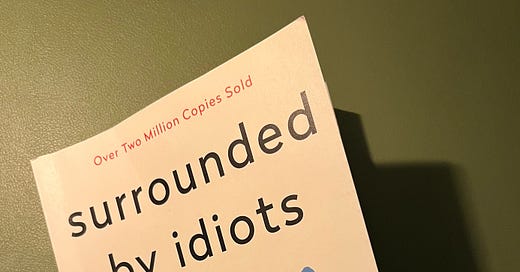An Analysis & Summary of Surrounded By Idiots by Thomas Erikson
The case for self-reflection as a key tool in leadership and personal development.
A Note Before You Read
My book summaries are different from other summaries you might read online. The actual summarization of texts in my posts is relatively short. I know you can't truly summarize a book in a paragraph or two, but I do this because it's not my objective to summarize the text. The objective is to reflect on the text and share its impact on my thinking. I think of my summaries like I think about why I gift someone a book. I gave the book because it impacted me; it made a difference and may make a difference for someone else. So please read, but do not think you will know a good deal about this book by reading this summary; there are other outlets for that (I also believe in reading the book). What you will get is me talking to a friend about how this book affected my thinking. I am sharing it with you because I hope it also makes a difference for you.
The Summary
"Surrounded By Idiots," - Thomas Erickson presents a compelling case for effective communication and understanding others' perspectives. The book introduces a color-coded system called DiSC to classify different behavioral patterns. 'Reds' are characterized by their competitiveness and confidence. They are often perceived as leaders due to their willingness to make quick or controversial decisions. 'Yellows,' on the other hand, are relationship-oriented and persuasive. They are typically the life of the party, using their whole body to make a point when they speak. 'Greens' are deferential and great listeners. They are often seen as common and unassuming, not sticking out much. Lastly, 'Blues' are analytical and data-driven. They are straight to the point and prioritize thoroughness over speed. Consider that most people, 85% of us to put a number to it, are more than one thing. Very few people are only a single color, but some lean further to one color than others.
What caught my eye early in the book and framed my approach to the reading was Erikson's mention of self-reflectiveness and its impact on our ability to judge other's behavior styles but, most importantly, understand our own. One of my favorite quotes is the quote, "know thyself." While it is easy to get caught up in the coding system as a means to categorize people for different reasons, I was more interested in how to use the DiSC system to better understand myself as a leader and a human being.
We often need to be made aware of how our actions and behaviors are perceived by others, and we are often unaware of our unconscious behaviors. This underscores the importance of self-reflection in understanding our behaviors and how others perceive them. This understanding can help us adjust our behaviors to fit better the context and the people we interact with. Knowing that I am a Greenish-Yellow is very empowering. It means that I have the capacity to sit back and listen without judgment. I can also take center stage when needed and effectively communicate my vision, ideas, or dissent. Understanding this means I can tap into either part of myself when required. However, it can also help me avoid the pitfalls of the two colors. I can't be too silent or silent for too long in a meeting because I am the leader. People are looking to me to be a Red at some point and make a decision. I also cannot be too much of a yellow. I have to make space for everyone else's voices in the room. Taking center stage too much and too long will shrink my team and keep me from hearing great ideas or unspoken uncertainties.
In the End…
If you have never taken the DiSC or heard of the DiSC survey, you should read this book. It's an expensive assessment, but the DiSC understood me better than the Meyers-Briggs or any other personality survey I've taken in the past. But when you read this book, look for the nuggets that force you to look into the mirror and pinpoint where you stand on the matrix. Erikson provides multiple examples of people who need help coming to terms with their results after taking the survey. I recommend that you not be one of those people, especially if you are in a leadership role. Instead, use this book as a guide to self-reflection. A means to better understand how you perceive others and, most importantly, how others perceive you.



